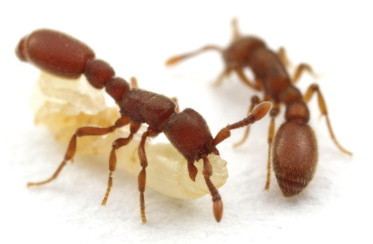Family Formicidae Rank Species | Subfamily Dorylinae | |
 | ||
Similar Cerapachys, Hymenopterans, Harpegnathos saltator, Platythyrea, Army Ants | ||
Ooceraea biroi, or the clonal raider ant, is a queenless clonal ant in the genus Ooceraea (recently transferred from the genus Cerapachys). Native to the Asian mainland, this species has become invasive on tropical and subtropical islands throughout the world. Unlike most ants, which have reproductive queens and mostly non-reproductive workers, all individuals in a O. biroi colony reproduce clonally via thelytokous parthenogenesis. Like most dorylines, O. biroi are obligate myrmecophages and raid nests of other ant species to feed on the brood.
Contents
Description
Clonal raider ants are small, ~2mm, but relatively stocky. Like many former cerapachyines, O. biroi are heavily armored, with the short, thick antennae which give the old subfamily its name (from Greek, keras/κέρας, meaning horn and pachys/παχυς, meaning thick). The other defining characteristic of the former Cerapachyinae, a row of teeth over the pygidium (last visible abdominal segment), is very small in O. biroi and difficult to see. O. biroi can be distinguished from many other former cerapachyines by the combination of highly reduced or non-existent eyes, rectangular head, and distinct post-petiole.
Cyclic life history
Like many myrmecophagous ants, O. biroi exhibit synchronized oviposition and cyclic behavior, shifting between a reproductive phase and a foraging phase. The reproductive phase begins when a cohort of larvae pupate and all the adults in the colony activate their ovaries. Thelytokously produced eggs are then laid synchronously after about four days and develop for roughly 10 days while the adults remain within the nest, cleaning and tending the eggs and pupae. Eggs hatch roughly two weeks into the reproductive phase, and then a few days later the foraging phase begins with emergence of new adults from the pupae. Adults will forage for the next two weeks, raiding the nests of other ant species to bring back food for the larvae. The cycle completes with the pupation of the new larval cohort and the resumption of the reproductive phase.
Genetics and genomics
Parthenogenesis is a natural form of reproduction in which growth and development of embryos occur without fertilisation. Thelytoky is a particular form of parthenogenesis in which the development of a female individual occurs from an unfertilized egg. Automixis is a form of thelytoky, but there are different kinds of automixis. The kind of automixis relevant here is one in which two haploid products from the same meiosis combine to form a diploid zygote. Because O. biroi can be very easily maintained in laboratory conditions, it has attracted attention as a potential model organism for studying the molecular biology of sociality. Laboratory maintenance is made easy by the clonality of the species; a few individuals placed in an airtight box and given ant brood as food can be grown up into many large colonies. Clonal reproduction is achieved by automixis with central fusion (see diagram), as is common in Hymenoptera, yet unlike most clonal Hymenoptera loss of heterozygosity is extraordinarily slow. The upshot of this is that offspring are almost genetically identical to the parent, allowing nearly complete control over the genotype of experimental subjects. Finally, since O. biroi are queenless and all workers reproduce, generation time is about two months (the developmental time of a single individual), rather than many years as is the case for most ant species.
